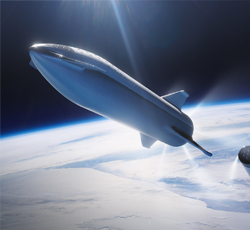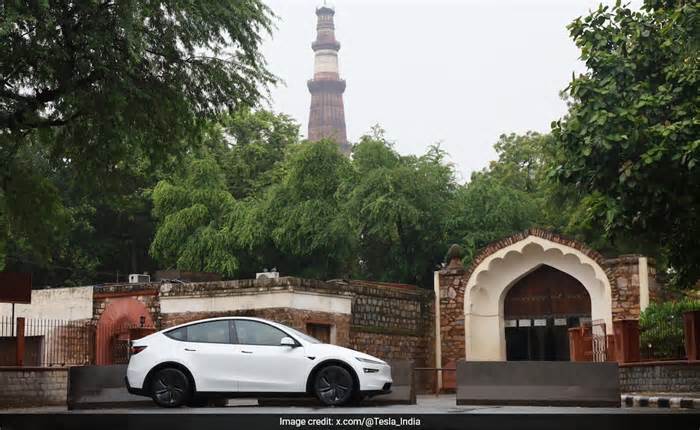
The Definitive Guide to SpaceX’s Starship Megarocket
- by Gizmodo
- Mar 23, 2023
- 0 Comments
- 0 Likes Flag 0 Of 5

Related article: Everything we noticed during SpaceX’s first big test of Starship megarocket
The Starbase orbital launch pad had “no water deluge system, flame trench, or thrust diverter” to reduce or dissipate the energy produced during the test, but despite this, the “flat concrete directly below the pad appeared to survive almost eight million pounds of thrust and brutal heat with only minor [fragmenting] and damage,” according to Teslarati. “The engines were only at half thrust for the static fire test,” Musk tweeted after Starship’s inaugural launch.
During the failed attempt to launch Starship on April 17, SpaceX quickly pivoted, turning the exercise into a full wet dress rehearsal with the countdown stopping at T-minus 40 seconds.
How will the first successful Starship mission unfold?
Neither of Starship’s first two flights ended in complete mission success, but here’s how the inaugural mission is supposed to go down.
After launching from Starbase in Boca Chica, the booster will separate, perform a partial return, and splash down in the Gulf of Mexico (a return at the catch tower isn’t likely during the first in-space flight). The booster will attempt to perform a controlled descent prior to landing in the water.
The Starship upper stage will keep going in its attempt to fly on an orbital-like trajectory, rising to a target altitude of approximately 155 miles (250 kilometers). Starship won’t attempt a full orbit of Earth, and instead re-enter and splash down roughly 62 miles (100 km) northwest of Kauai, Hawaii. The upper stage is not expected to survive the water landing, as it will hit the ocean at high velocity.
What kinds of regulatory hurdles does SpaceX need to address?
Starship prototype SN15 during the first and only successful vertical landing of the upper stage, May 5, 2021.
Photo: SpaceX
SpaceX’s Boca Chica facility is home to threatened wildlife, including at-risk shorebirds. An environmental assessment completed by the Federal Aviation Administration in June 2022 listed 75 environmental mitigation actions that SpaceX needed to complete to qualify for a Starship launch license. These mitigations included measures to ensure good air quality, reduce noise pollution, prevent wildfires, and protect cultural resources, water quality, and wildlife.
The FAA concluded that its decision to award a Starship launch license “conforms to the prior environmental documentation” and that “there are no significant environmental changes, and all pertinent conditions and requirements of the prior approval have been met or will be met in the current action.”
In 2022, the Sierra Club and a south Texas group of indigenous peoples unsuccessfully sued the Texas General Land office, the complaint being the claim that the repeated beach closures—a result of SpaceX Starship tests—were unconstitutional.
Why doesn’t Starship have an abort system?
One of the more controversial aspects of Starship is the complete absence of an emergency launch abort system. Many launch systems, both past and present, feature abort systems, which quickly jetsons crew capsules away from failing rockets. NASA’s Orion, Russia’s Soyuz, SpaceX’s Crew Dragon, Blue Origin’s New Shepard, and Boeing’s Starliner, all feature abort systems, but Starship does not and will not.
Starship prototype SN during a suborbital test flight, February 3, 2021.
Photo: SpaceX
“Rockets carrying people should have abort systems,” United Launch Alliance CEO Tory Bruno tweeted in December 2019 in response to this omission. It’s worth noting that NASA’s Space Shuttle didn’t feature an abort system, which proved deadly during the 1986 Challenger disaster. And of course, passenger aircraft don’t feature abort systems, either, and that doesn’t prevent (most of) us from flying.
Tim Dodd of Everyday Astronaut provided a detailed explanation in a 2019 article, saying Starship doesn’t have an abort system on account of Starship’s engine reliability (a failing Raptor engine won’t affect the performance of neighboring engines) and that the upper stage could conceivably serve as an escape vehicle should the booster fail. Dodd even questioned the need for an abort system, saying that, to date, “a mechanical abort system has only saved lives twice, may have prevented one tragedy and in one case caused a death.” Musk himself has said that atmospheric reentries are more dangerous than launches. That said, it’s an open question as to whether NASA, or the FAA for that matter, will buy into all of this when considering Starship as a launch vehicle fit for humans.
How does SpaceX plan to use Starship?
The megarocket will, first and foremost, serve as a satellite delivery mechanism. SpaceX will use Starship to deploy its oversized next-generation Starklink satellites, and also satellites belonging to paying customers, whether private or public. Due to its immense lifting capacity and oversized fairing, Starship should enable entirely new possibilities for future spacecraft—including spacecraft larger than the recently deployed Webb Space Telescope. Starship could also deliver cargo and crew to the International Space Station, as it’ll be capable of docking at the station.
Please first to comment
Related Post
Stay Connected
Tweets by elonmuskTo get the latest tweets please make sure you are logged in on X on this browser.
Sponsored
Popular Post
Sam Altman's OpenAI Takes On Elon Musk's Grok in AI Chess Tournament Final - Who Won?
28 ViewsAug 09 ,2025






 Energy
Energy


















